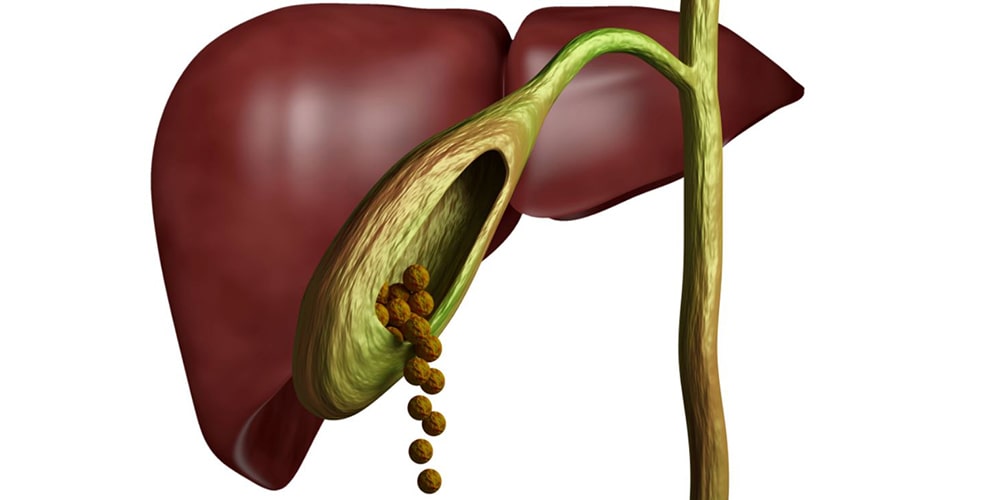
Gallstones are a type of stone that forms in the gallbladder or bile ducts (the pipe-like system within the liver). Gallstones can range in size from microscopic grains of sand to golf ball-sized objects. Surprisingly, tiny stones are typically the most troublesome. These are stones that can pass through the gallbladder and become lodged. Larger stones are more likely to remain silent in the gallbladder. It’s crucial to remember that many people with gallstones aren’t aware they have them because they aren’t troubled by them.
What are gallstones made of?
Gallstones are made up of hardened materials in your body. Typically, there are two types:
- Cholesterol: Made up of fatty substances in the blood, cholesterol is found throughout the body. These are the most common type of gallstones.
- Pigment Stones (mainly made of bilirubin): This substance is created when red blood cells break down in the liver. Too much bilirubin can actually leak into the bloodstream and cause the skin and eyes to turn yellow (jaundice).
Gallstones that are made up of cholesterol tend to be greenish in color. It is more common to have gallstones made of cholesterol than other types of stone.
Services
Process Safety Management
Process Safety Management also known as PSM is an effective safety management system, that aids process industry workers and others by helping to prevent fires, explosions, or chemical discharges that could put their health and safety at risk.
It’s a systemic approach that aims to reduce the frequency and severity of accidents involving the release of highly hazardous chemicals. When it comes to establishing PSM standards, a combination of federal and national laws, regulations, directives, and their interpreted meanings are used together with integrated technology and management practices.
NorthStar Process Safety Management
NorthStar EHS focuses on protecting your workers by reviewing procedures in running facilities that include extremely hazardous chemicals while keeping systems streamlined and contaminants contained in the environment. Our highly trained team of engineers, safety experts, and former Process Operators work hard to get a thorough understanding of your process (es). We constantly seek input from the facility to ensure that the Process Safety Management programme we develop is realistic and feasible.
As a global leader NorthStar also assesses the above-mentioned qualities and customizes the PSM system to meet the facility’s needs using the Risk Based Process Safety (RBPS) criteria produced by the Centre for Chemical Process Safety (CCPS) and OSHA PSM guidelines.
This strategy aims to ensure that the facility is in good working order.
- Process Safety is a Priority
- Hazards and Risks are well-understood.
- Effectively Manage Risk
- Experience-Based Learning
Measurement and Metrics, Operational Readiness (OR) and Process Safety Competency (PSC) all help the facility better identify and manage the hazards it faces. The goal of this technique to determining process safety is to influence stakeholders’ attitudes toward the hazards associated with the process industry.
NorthStar begins by performing a PSM gap analysis to determine the current state of the facility. As a result, everything are put into proper perspective. Workshops and training programme are set up in a systematic way to close the knowledge gap and make PSM implementation and integration easier.
Services Offered
PSM Audit/ PSM GAP Analysis
- Process Safety Management
One of the most essential components of the PSM system is the gap assessment, which includes detecting flaws in the PSM system, technical safety infrastructure, planning, capability, follow-up, and how the PSM system is documented. A PSM Gap Assessment is a series of assessments used to detect gaps and issue areas in the Risk Based PSM programor that are installed in operation, design, and maintenance. The review enables proper gap identification at the start of a project and provides a detailed list of system/people/physical gaps that can pose catastrophic dangers to the facility; based on this list, it is possible to ensure the monitoring and traceability of the implementation of measures to help avoid them. The elements that are being evaluated are
- Risk Based Thinking
- Governance and Organization
- Process Safety Information
- Process Hazards Review Analysis
- Operating Procedures
- Management of Change
- Pre Startup safety review
- Training
- Employee Participation
- Trade Secret
- Mechanical Integrity
- Incident Investigation
- Emergency Response
- Contractors
- Hot Work
- Compliance Audits
- Risk Assurance
- Workplace Safety Management
A workplace safety gap analysis might include a variety of evaluations aimed at identifying strengths and areas for development. Experts from NorthStar can identify critical areas that require immediate attention and collaborate with you to develop health and safety improvement strategies and activities at your business. We work on the following essential elements for workplace improvement.
- Work at height
- Confined Space
- Permit to work
- Auditing
- Accident Investigation
- Material Handling
- Logisitcs Safety
- Internal Audits
- Electrical Safety
- Emergency Plan
- Machine Safety
After workplace safety gap assessment due diligence is demonstrated through our reports:
- Gaining and maintaining a working knowledge of OHS issues
- Comprehend corporate processes and the hazards and risks that come with them at the workplace safety system
- Ensure that suitable resources and processes are in place to eliminate or reduce health and safety concerns.
- There is a defined communication strategy in place for incident, hazard, and risk information, as well as a fast response to such information.
- Managers, employees, and others connected in your organiz ation should receive safety training.
Implementation of PSM System- Handholding & Support
NorthStar offers a team of experienced individuals who can assist businesses in implementing Process Safety Management Systems in their plants.
NorthStar uses the Centre for Chemical Process Safety (CCPS) Risk Based Process Safety (RBPS) recommendations and OSHA PSM criteria to achieve the following features while tailoring the PSM system to meet the facility’s needs.
- Process Safety Commitment
- A process plant’s hazards and risks should be understood.
- Effective Risk Management
- Experiential Learning
The following broad actions are included in the execution of the Process Safety Management System:
- PSM Gap Analysis Workshop for all levels of the organization on PSM.
- Creating a PSM User’s Guide
- team for PSM implementation in the company
- Incorporating PSM components
- Training the implementation team in-depth on each PSM element and putting that knowledge to use in the plant’s current operations.
- Format and template development
- Preparation for various PHA methods
- Using newsletters to spread the PSM message
- Identifying areas for improvement in PSM elements based on an evaluation of compliance in the field
- Provide assistance in conducting an independent third-party PSM audit.
PSM instruction
NorthStar offers Process safety training programme that are specifically tailored to meet the needs of the clients.
The following are examples of training programme topics:
- Process Hazard Analysis (PHA)
- Process Safety Management (PSM)
- Project HSE Review (PHSER)
- Safety Integrity level (SIL)
- E-videos and modules on Plant Requirements (Refer to coastal videos) etc.
HAZOP, QRA, and Other PHA Studies
Process Hazard Analysis (PHA) is a method for finding, analyzing, and controlling process hazards that is thorough, order, and systematic.
In fact, a PHA is a detailed, step-by-step examination of chemical and manufacturing facility methods. The purpose is to determine the sources of hazardous chemical emissions and assess the consequences. The method aids firms in identifying a variety of hazards, ranging from equipment failures to human factors, as well as enhancing safety, reducing downtime, and safeguarding the environment.
The process hazard analysis approach chosen must be appropriate for the process’s complexity and must identify, analyse, and control the process’s dangers.
The following issues is addressed in the process hazard analysis:
- The dangers of the procedure
- Identification of any past incident with a high likelihood of having disastrous effects
- Hazard-specific engineering and administrative controls, as well as their interdependencies.
- Failure of engineering and administrative controls has a number of consequences.
- Location of a stationary source
- Human factors as well as
- A qualitative assessment of a variety of potential safety and health consequences of control failure.
Process safety specialists, engineers, operators, supervisors, and other professionals who are familiar with the standards, rules, specifications, and regulations that apply to the process under investigation make up a Process Hazard Analysis (PHA) team.
PHA Services Offered by NorthStar:
- Hazard and Operability Study (HAZOP)
- Hazard Identification Study (HAZID)
- Bow-Tie Analysis
- What-If Analysis
- Quantitative Risk Assessment (QRA).
Make an appointment
Our Doctors
-
Dr. Sujoy Kr. Bhattacharjee
Joint Replacement -
Dr. (Maj.) Mukesh Garg
Orthopaedics & Arthroscopy -
Dr. Kamal Verma
Neuro Sciences


